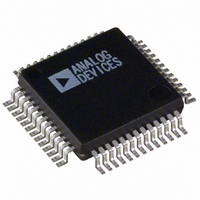AD1835AASZ Analog Devices Inc, AD1835AASZ Datasheet - Page 21

AD1835AASZ
Manufacturer Part Number
AD1835AASZ
Description
Audio Codec 2ADC / 8DAC 24-Bit 52-Pin MQFP
Manufacturer
Analog Devices Inc
Type
General Purposer
Datasheet
1.AD1835AASZ.pdf
(24 pages)
Specifications of AD1835AASZ
Package
52MQFP
Adc/dac Resolution
24 Bit
Number Of Channels
2ADC /8 DAC
Sampling Rate
96 KSPS
Number Of Adcs
2
Number Of Dacs
8
Operating Supply Voltage
3.3|5 V
Data Interface
Serial
Resolution (bits)
24 b
Number Of Adcs / Dacs
2 / 8
Sigma Delta
Yes
S/n Ratio, Adcs / Dacs (db) Typ
105 / 108
Dynamic Range, Adcs / Dacs (db) Typ
105 / 108
Voltage - Supply, Analog
4.5 V ~ 5.5 V
Voltage - Supply, Digital
4.5 V ~ 5.5 V
Operating Temperature
-40°C ~ 85°C
Mounting Type
Surface Mount
Package / Case
52-BQFP
Lead Free Status / RoHS Status
Lead free / RoHS Compliant
For Use With
EVAL-AD1835AEB - BOARD EVALUATION FOR AD1835A
Lead Free Status / RoHS Status
Lead free / RoHS Compliant
Available stocks
Company
Part Number
Manufacturer
Quantity
Price
Company:
Part Number:
AD1835AASZ
Manufacturer:
ADI
Quantity:
30
Company:
Part Number:
AD1835AASZ
Manufacturer:
Analog Devices Inc
Quantity:
10 000
Company:
Part Number:
AD1835AASZ-REEL
Manufacturer:
Analog Devices Inc
Quantity:
10 000
CASCADE MODE
Dual AD1835A Cascade
The AD1835A can be cascaded to an additional AD1835A
which, in addition to six external stereo ADCs, can be used to
create a 32-channel audio system with 16 inputs and 16 outputs.
The cascade is designed to connect to a SHARC DSP and oper-
ates in a time division multiplexing (TDM) format. Figure 16
shows the connection diagram for cascade operation. The digital
interface for both parts must be set to operate in Auxiliary 512
mode by programming ADC Control Register 2. AD1835A No. 1
is set as a master device by connecting the M/S pin to DGND
and AD1835A No. 2 is set as a slave device by connecting the
M/S to ODVDD. Both devices should be run from the same
MCLK and PD/RST signals to ensure that they are synchronized.
REV. A
(SLAVE)
SHARC
ABCLK
TFSx/
DTx
DRx
RFSx
RCLKx
TCLKx
DTx
DRx
RFSx
TFSx
DRx
DTx
L1
L1
AUX ADC
(SLAVE)
L2
MSB
L2
MSB
ASDATA
ALRCLK
ABCLK
AD1835A No. 1 DACs
AD1835A No. 1 ADCs
Figure 17. Dual AD1835A Cascade Timing
L3
L3
MSB – 1
MSB – 1
256 ABCLKs
Figure 16. Dual AD1835A Cascade
AUX ADC
L4
L4
(SLAVE)
R1
R1
32 ABCLKs
R2
R2
AD1835A No. 1
LSB
LSB
(MASTER)
AUX ADC
(SLAVE)
R3
R3
DSDATA
–21–
R4
R4
DON’T CARE
With Device 1 set as a master it will generate the frame-sync and
bit clock signals. These signals are sent to the SHARC and
Device 2, ensuring that both know when to send and receive data.
The cascade can be thought of as two 256 bit shift registers, one for
each device. At the beginning of a sample interval, the shift regis-
ters contain the ADC results from the previous sample interval.
The first shift register (Device 1) clocks data into the SHARC and
clocks in data from the second shift register (Device 2). While this
is happening, the SHARC is sending DAC data to the second shift
register. By the end of the sample interval, all 512 bits of ADC data
in the shift registers will have been clocked into the SHARC and
replaced by DAC data, which is subsequently written to the DACs.
Figure 17 shows the timing diagram for the cascade operation.
L1
L1
L2
L2
AUX ADC
(SLAVE)
AD1835A No. 2 DACs
AD1835A No. 2 ADCs
L3
L3
256 ABCLKs
ASDATA
ALRCLK
ABCLK
L4
L4
R1
R1
AUX ADC
(SLAVE)
R2
R2
R3
R3
AD1835A No. 2
(SLAVE)
AUX ADC
R4
(SLAVE)
R4
DSDATA
AD1835A








